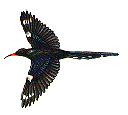
Dr Grant Joseph
MBChB (UCT); MSc CB (UCT); PhD (UCT)
Grant is both a practicing medical practitioner and research scientist. Following 10 years of medical practice, he completed an MSc in Conservation Biology and a PhD in Zoology. Research interests include Conservation Biology, Landscape Ecology, Community Ecology, Restoration Ecology, ornithology, and the emerging threats to human health from global environmental change. He is presently investigating the influence of termitaria on biodiversity and resilience in dystrophic savannah systems, restoration of semi-arid systems, the effects of environmental change on bird functional distribution across gradients of aridity, and on ecological systems and human health. He believes that through education and shared knowledge with the general public and commercial institutions, scientists can play a decisive role in achieving a sustainable future in which the wonder of four billion years of life is respected, and better understood by all.
Recent peer-reviewed publications
2025
Phelps, L.N., Razanatsoa, E., Davis, D.S., Hackel, J., Rasolondrainy, T., Tiley, G.P., Burney, D., Cox, R., Godfrey, L., Hempson, G.P., Hixon, S., … Joseph, G.S., … Seymour, C. et al. 2025. Advancing transdisciplinary research on Madagascar's grassy biomes to support resilience in ecosystems and livelihoods. Ecological Monographs 95 IF: 7.5 https://doi.org/10.1002/ecm.70011
Turner, A.A., Clark, M.L., Salas, L., Seymour, C., Snyder, R.L., Lee, A.T.K., Ferraz, A., Schneider, F., Measey, J., Huisamen, J., Cloete, D., Hofmeyr, S.D., Hagen, C., Leland, D.F., Schackwitz, W., Adegbola, F., Hahndiek, E., Joseph, G.S., Van Rooi, J., Fuchs, M., Thomas, S., Madlala, S., Spiby, J. and Taljaard, P. 2025. BioSoundSCape: A bioacoustic dataset for the Fynbos Biome. Scientific Data 12(1). https://doi.org/10.1038/s41597-025-05685-3
2024
Joseph, G.S., Randriatsara, F., Rakotoarivelo, A.R., Rafidiarimanda, A.A. and Seymour, C.L. 2024. Across Madagascar, treeless grasslands characterised by erosion gullies are named after forest and trees. Plants People Planet. https://doi.org/10.1002/ppp3.10542
Joseph, G.S., Rakotoarivelo, A.R., Pedrono, M. and Seymour, C.L. 2024. Can rewilding with giant tortoises increase woody habitat and limit fire across Madagascar's grasslands?. Plants People Planet. https://doi.org/10.1002/ppp3.10474
Joseph, G.S. and Seymour, C.L. 2024. Commentary: The role of palaeoecology in reconciling biodiversity conservation, livelihoods, and carbon storage in Madagascar. Frontiers in Conservation Science 5. https://doi.org/10.3389/fcosc.2024.1389498
2023
Joseph, G.S., Seymour, C.L. and Rakotoarivelo, A.R. 2023. Fire incongruities can explain widespread landscape degradation in Madagascar's forests and grasslands. Plants, People, Planet. https://doi.org/10.1002/ppp3.10471
Joseph, G.S. and Seymour, C.L. 2023. Anthropogenic disturbance, not topographic dispersal barriers, limit forest and maintain Madagascar's derived savannas. Bull Ecol Soc Am 00(00):e02087. https://doi.org/10.1002/bes2.2087
Joseph, G.S., Rakotoarivelo, A.R. and Seymour, C.L. 2023. A review of Madagascar's derived grasslands: Low palatability following anthropogenic fires may threaten food security. Plants, People, Planet 1-12. DOI: 10.1002/ppp3.10408
Mills, M.S.L. and Joseph, G.S. 2023. Obituary: W.Richard J. Dean: 1940-2022. Bulletin of the African Bird Club 30(1): 126-127.
Seymour, C.L., Korb, J., Joseph, G.S., Hassall, R. and Coetzee, B.W.T.. 2023. Need for shared internal mound conditions by fungus-growing
Macrotermes does not predict their species distributions, in current or future climates. Phil. Trans. R. Soc. B 378: 20220152.
https://doi.org/10.1098/rstb.2022.0152
2022
Joseph, G.S. and Seymour, C.L. 2022. Dispersal liitation and fire feedbacks maintain mesic savannas in Madagascar: Comment. Ecology. https://doi.org/10.1002/ecy.4045
Joseph, G.S. and Seymour, C.L. 2022. Why have Madagascar's mammals, despite being closely-related to African open-habitat specialists, failed to radiate into open grasslands? Journal of Biogeography. https://doi.org/10.1111/jbi.14550
Joseph, G.S. and Seymour, C.L. 2022. Are Madagascar’s obligate grazing-lawns ancient and evolved with endemic herbivores, or recently selected by introduced cattle? Biology Letters, 18(9). https://doi.org/10.1098/rsbl.2022.0212
Seymour, C.L., Joseph, G.S., Calitz, W., Henschel, J.R., Ramaswiela, T., van der Merwe, H. and Peters, D.P.C. 2022. Mean height increase in saplings of a keystone woody savanna species over 15 years similar to that over a single season. Ecosphere, 13(9). https://doi.org/10.1002/ecs2.4173
Joseph, G.S., Rakotoarivelo, A.R. and Seymour, C.L. 2022. Tipping points induced by palaeo-human impacts can explain presence of savannah in Malagasy and global systems where forest is expected. Proceedings of the Royal Society B. 289:20212771.
2021
Joseph, G.S. and Seymour, C.L. The unlikely ‘antiquity of Madagascar's grasslands’: Disproportionately forestâlimited endemic fauna support anthropogenic transformation from woodland. Journal of Biogeography. https://doi.org/10.1111/jbi.14132
Joseph, G.S., Rakotoarivelo, A.R., Seymour, C.L., 2021. How expansive were Malagasy Central Highland forests, ericoids, woodlands and grasslands? A multidisciplinary approach to a conservation conundrum. Biological Conservation 261: 109282. https://doi.org/10.1016/j.biocon.2021.109282
Muluvhahothe, M.M., Joseph, G.S., Seymour, C.L., Munyai, T.C. and Foord, S.H. 2021. Repeated surveying over 6 years reveals that fineâscale habitat variables are key to tropical mountain ant assemblage composition and functional diversity. Scientific Reports 11(56). https://doi.org/10.1038/s41598-020-80077-8
Ndlovu, M, Nampa, G., Seymour, C.L. and Joseph, G. 2021. Plant shade enhances thermoregulation of internal environments in Trinervitermes trinervoides mounds. Journal of Thermal Biology, 100: 103068. https://doi.org/10.1016/j.jtherbio.2021.103068
2020
Kattge, J. and Joseph, G.S. (and 727 other authors). 2020. TRY plant trait database–enhanced coverage and open access. Global change biology 26: 119–188. https://doi.org/10.1111/gcb.14904
Joseph, G.S. and Seymour, C.L. 2020. Madagascan highlands: originally woodland and forest containing endemic grasses, not grazing-adapted grassland. Proceedings of the Royal Society B 287. http://dx.doi.org/10.1098/rspb.2020.1956
Seymour, C.L., Milton, S.J., Altwegg, R., Joseph, G.S. and Dean, W.R.J. 2020. Addition of nitrogen increases variability of vegetation cover in an arid system with unpredictable rainfall. Ecosystems, 23(1): 175-187. https://doi.org/10.1007/s10021-019-00396-4
2019
Dean, W.R.J., Seymour, C.L., Joseph, G.S. and Foord, S.H. 2019. A Review of the Impacts of Roads on Wildlife in Semi-Arid Regions. Diversity 11(5). doi:10.3390/d11050081.
Joseph, G.S., Muluvhahothe, M.M., Seymour, C.L., Munyai, T.C., Bishop, T.R. and Foord, S. 2019. Stability of Afromontane ant diversity decreases across an elevation gradient. Global Ecology and Conservation. https://doi.org/10.1016/j.gecco.2019.e00596
Seymour, C. and Joseph, G.S. 2019. Ecology of smaller animals associated with savanna woody plants. The value of the finer details. pg 183-212. In Scogings, P.F. and Sankaran, M. (eds). Savanna woody plants and large herbivores,ISBN: 978-1-119-08110-4. 784 pages.
2018
Dean, W.R.J, Seymour, C.L. and Joseph, G.S. 2018. Linear structures in the Karoo, South Africa, and their impacts on biota. African Journal of Range & Forage Science 35 (3-4), 223-232. https://doi.org/10.2989/10220119.2018.1514530
Joseph, G.S., Seymour, C.S., Coetzee, B.W.T., Ndlovu, M., Luana Deng, L., Fowler, K., Hagan, J., Brooks, B.J., Seminara, J.A. and Foord, S.H. 2018. Elephants, termites and mound thermoregulation in a progressively warmer world. Landscape Ecology. https://doi.org/10.1007/s10980-018-0629-9
Simba, L.D. Foord; S.H., Thebault, E. ; Van Veen, F.J., Joseph, G.S. and Seymour, C.L.. 2018. Indirect interactions between crops and natural vegetation through flower visitors: The importance of temporal as well as spatial spillover . Agriculture, Ecosystems and Environment 253: 148-156. https://doi.org/10.1016/j.agee.2017.11.002
2017
Joseph, G.S., Mauda, E.V., Seymour, C.L., Thinandavha C. Munyai, T.C., Dippenaar-Schoeman, A. and Foord, S.H. 2017. Landuse change in savannas disproportionally reduces functional diversity of invertebrate predators at the highest trophic levels: spiders as an example. Ecosytems.21(5): 930-942.
Joseph, G.S., Seymour, C.L. and Foord, S.H.. 2017. The effect of infrastructure on the invasion of a generalist predator: Pied crows in southern Africa as a case-study. Biological Conservation (205) 11-15.
Mauda, E.V., Joseph, G.S., Seymour, C.L., Munyai, T.C., Foord, S.H. 2017. Changes in landuse alter ant diversity, assemblage composition and dominant functional groups in African savannas. Biodiversity and Conservation 1-19.
Modiba, R.V, Joseph, G.S., Seymour, C.L., Fouché, P. and Foord, S.H. 2017. Restoration of riparian systems through clearing of invasive plant species improves functional diversity of Odonate assemblages. Biological Conservation 214, 46-54.
2016
Joseph, G.S., Seymour, C.L., Coetzee, B.T.W., Ndlovu, M., de la Torre, A., Suttle, R., Hicks, N., Oxley, S. and Foord, S.H. 2016. Microclimates mitigate against hot temperatures in dryland ecosystems: termite mounds as an example. Ecosphere 7(11) e01509. doi: 10.1002/ecs2.1509.
Seymour, C.L., Joseph, G.S., Makumbe, M., Cumming, G.S., Mahlangu & Cumming, D.H.M. 2016. Woody species composition in an African savanna: determined by centuries of termite activity but modulated by 50 years of ungulate herbivory. Journal of Vegetation Science Doi: 10.1111/jvs.12393.
2015
Seymour, C.L., Simmons, R.E., Joseph, G.S. & Slingsby, J.A. 2015. On bird functional diversity: species richness and functional differentiation show contrasting responses to rainfall and vegetation structure in an arid landscape. Ecosystems. Doi: 10.1007/s10021-015-9875-8.
Joseph, G.S., Makumbe, M., Seymour, C.L., Cumming, G.S., Mahlangu, Z., and Cumming, D.H.M. 2015. Termite mounds mitigate against 50 years of herbivore-induced reduction of functional diversity of savanna woody plants. Landscape Ecology 30: 2161-2174. doi:10.1007/s10980-015-0238-9.
2014
Joseph, G.S., Seymour, C., Cumming, G.S., Cumming, D.H.M., and Mahlangu, Z. 2014. Termite mounds increase functional diversity of woody plants in African savannas. Ecosystems. DOI: 10.1007/s10021-014-9761-9
Seymour, C.L., Milewski, A.V., Mills, A.J., Joseph, G.S., Cumming, G.S., Cumming, D.H.M. & Mahlangu, Z. 2014. Do the large termite mounds of Macrotermes concentrate micronutrients in addition to macronutrients in nutrient-poor African savannas? Soil Biology and Biochemistry 68:105-105.
2013
Dean, W.R.J., Franke, U., Joseph, G.S., Gonçalves, F.M., Mills, M.S.L., Milton, S.J., Monadjem, A. & Oschadleus, H.D. 2013. Further breeding records for birds (aves) in Angola. Durban Natural Science Museum Novitates (36) 1-10.
Joseph, G.S., Seymour, C., Cumming, G.S., Cumming, D.H.M. & Mahlangu, Z. 2013. Termite mounds as islands: woody plant assemblages relative to termitarium size and soil properties. Journal of Vegetation Science 24(4) 702-711.
Joseph, G.S., Seymour, C., Cumming, G.S., Mahlangu, Z. & Cumming, D.H M. 2013. Escaping the flames: large termitaria as refugia from fire in miombo woodland. Landscape Ecology doi:10.1007/s10980-013-9897-6.
Seymour, C., Milewski, A.V., Mills, A.J., Joseph, G.S., Cumming, G.S., Cumming, D.H.M., and Mahlangu, Z. 2013. Do the large termite mounts of Macrotermes concentrate both micro- and macronutrients in nutrient-poor African savannas? Soil Biology and Biochemistry (68) 105-105.
2012
Dean, W.R.J., Franke, U., Joseph, G.S., Gonçalves,F.M.. Mills, M.S.L., Milton,S.J., Monadjem, A. & Oschadleus, H.D. 2012. Type specimens in the bird collection at Lubango, Angola. Bulletin of the British Ornithologists' Club 132:41-45.
2011
Joseph, G.S., Cumming, G.S., Cumming, D.H.M., Mahlangu, Z., Altwegg, R. & Seymour, C. 2011. Large termitaria act as refugia for tall trees, deadwood and cavity-using birds in a miombo woodland. Landscape Ecology 26:439-448.
2010
Child, M.F., Milton, S.J., Dean, W. R. J., Lipsey, M. K., Puttick, J., Hempson, T. N., Mann, G. K., Babiker, H., Chaudrey, J., Humphrey, G., Joseph, G.S., Okes, N. C., Potts, R. and Wistebaar, T. 2010. Tree-grass coexistence in a flood-disturbed, semi-arid savanna system. Landscape Ecology 25(2):315-326.
Mills, M.S.L., Franke, U. Joseph, G.S., Miato, F., Milton, S., Monadjem, A., Oschadleus, D. & Dean, W.R.J. 2010. Cataloguing the Lubango Bird Skin Collection: towards an atlas of Angolan bird distributions. Bulletin of the African Bird Club 17:43-53.
Seymour, C.L., Milton, S.J., Joseph, G.S., Dean, W.R.J., Ditlhobolo, T. & Cumming, G.S. 2010. Twenty years of rest returns grazing potential, but not palatable plant diversity, to Karoo rangeland, South Africa. Journal of Applied Ecology 47:859-867.

